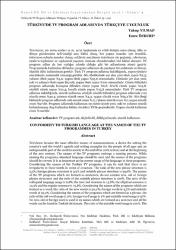TÜRKİYE'DE TV PROGRAM ADLARINDA TÜRKÇEYE UYGUNLUK
Abstract
Televizyon, 20. asrın sonları ve 21. asrın başlarında en etkili iletişim aracı olmuş, ülke ve dünya gündeminin belirlendiği araç hâlini almış, her yaştan insanlar için örneklik, televizyon yoluyla sunulur olmuş, eskilerin meydanını televizyon ele geçirmiş, televizyon, modern toplumun ve toplumsal yaşamın olmazsa olmazlarından biri hâlini almıştır. TV program adları da her varlığın adında olduğu gibi bir adlandırma süreci geçirir. Programlarda kullanılan dil kadar, program adlarının da yanlışsız bir anlatımla verilmesi, ölçünlü dilin kullanılması gerekir. Türk TV program adlarına bakıldığında, yapısı yönüyle sözcüklerde kuralsızlık yoktur. Söz öbeklerinde yer alan yeni öbek yapısı %2,3; yabancı öbek yapısı %3,9; uygun öbek yapısı %93,6 oranındadır. Cümlede yer alan yeni, eski ve yabancı öbek yapısı hiç yok; uygun öbek yapısı %100 oranındadır. Cümle hâlindeki program adlarında konuşma dilinden cümle yapısı %6,8; devrik cümle yapısı %13,8; eksiltili cümle yapısı %10,3; kurallı cümle yapısı %75,8 oranındadır. Türk TV program adlarına bakıldığında, sözcük kullanımı yönüyle sözcük hâlindeki program adlarında yeni sözcük oranı %30,4; yabancı sözcük oranı %4,3; uygun sözcük oranı %65,2'dir. Söz öbeği hâlindeki program adlarında eski sözcük oranı %2; yabancı sözcük oranı %2; uygun sözcük oranı %97'dir. Program adlarında kullanılan 29 cümle içinde yeni, eski ve yabancı sözcük kullanılmamış olup kullanılan bütün sözcükler TS'de geçmektedir. Uygun sözcük kullanım oranı %100'dür. Television became the most effective means of communication, a device for setting the country's and the world's agenda and setting examples for the people of all ages and an indispensable part of the modern society at the end of the 20th century and at the beginning of the 21st century. The names of the TV programs undergo a naming process. While naming the programs, standard language should be used and the names of the programs should be correct. It is as important as the correct usage of the language in these programs. Considering the names of the Turkish TV programs, it can be said that there is no irregularity in these words in terms of structure. The ratio of the new phrase structure is 2,3%; foreign phrase structure is 3,9% and suitable phrase structure is 93,6%. The names of the TV programs which are formed as sentences, do not contain new, old or foreign phrase structures and the ratio of the suitable phrase structure is 100%. The ratio of the colloquial language usage is 6,8%; the inverted structure is 13,8%; the elliptical sentence is 10,3% and the regular sentence is 75,8%. Considering the names of the programs which are formed as a word, the ratio of the new words is 30,4%; foreign words is 4,3% and suitable words is 65,2%. Considering the names of the programs which are formed as a phrase, the ratio of the old word usage is 2%; foreign word usage is 2% and suitable word usage is 97%. No new, old or foreign word is used in 29 names which are formed as a sentence and all the words can be found in Turkish dictionary. The ratio of the suitable word usage is 100%. The usage of Turkish while naming the TV programs showcases the characteristics of the standard Turkish in terms of structure and the usage of words.
Source
RumeliDE Dil ve Edebiyat Araştırmaları DergisiVolume
0Issue
7Collections
- Makale Koleksiyonu [624]
- TR-Dizin İndeksli Yayınlar Koleksiyonu [1037]



















